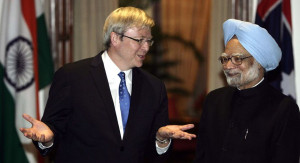India country strategy ”“ Australia’s blueprint for future engagement
27 August 2013. The Prime Minister today outlined Australia’s blueprint for future engagement with India through the Australia in the Asian Century Country Strategy for India.
Australia’s relationship with India has perhaps the greatest potential to grow out of all of Australia’s significant bilateral relationships in Asia. There are 450,000 people of Indian descent in Australia, the fourth largest migrant community in Australia.
There is no greater symbol of the ties we share with India than the contribution and successes of the Indian diaspora who have made Australia home.
India is a significant global power and the world’s largest democracy. With a current population of 1.2 billion, India is projected to overtake China as the world’s most populous nation by 2028.
The India Country Strategy outlines a vision of where Australia’s relationship with India should be in 2025 across community, business and government.
It outlines a plan for deepening cultural understanding, including by increasing fluency of Hindi in Australian schools and working with the significant Indian community in Australia.
The Strategy aims to achieve a threefold increase of two-way trade by 2025, with India becoming one of Australia’s top five trading partners. India is currently Australia’s 10th largest trading partner, with trade worth $17.5 billion. India’s growing middle class, estimated to reach 606 million by 2030, is creating new opportunities for Australian exporters.
In 2009 Kevin Rudd and Indian Prime Minister Dr Manmohan Singh elevated the bilateral relationship to a Strategic Partnership. Since then, Australia and India have exchanged over 50 high-level visits. Leaders now meet annually.
Under the Country Strategy launched today, Australia will continue to strengthen government dialogue, including in forums such as the East Asia Summit and the G20, and will build a more comprehensive defence and security relationship.
The Prime Minister thanked the Australian community for its contribution to the development of the strategies. Consultations were held across Australia throughout April and May with business, academia, local government, youth groups, and community organisations participating in roundtables and public forums in each State and Territory capital.
The India Country Strategy and information on the public consultations and submissions can be found at http://www.dfat.gov.au/issues/asian-century/.
Short URL: https://indiandownunder.com.au/?p=2497

